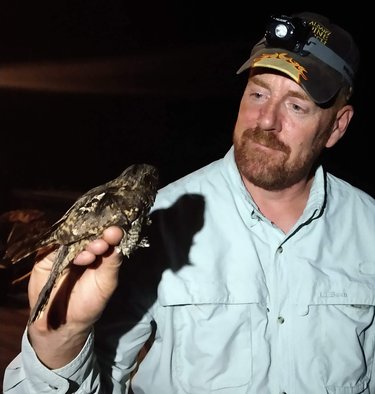Neil Gifford brings back birds and butterflies from the brink of extinction
GUILDERLAND — For Neil Gifford, fire is a tool.
While many of us think of fire solely as a destructive force, Gifford understands that it is essential to enriching the ecosystem of a pitch pine barren.
Gifford, the conservation director for the Albany Pine Bush Preserve, got his first job at the preserve literally setting fires, controlled burns.
Fire, he explains in this week’s Enterprise podcast, recycles nutrients in a way that benefits rare plants.
“You can think of wild fire almost like instant decomposition,” he said, likening it to what happens in a compost pile — but almost instantly.
“Fire is taking nitrogen in particular, but also phosphorus, calcium, potassium, and other nutrients and releasing them into the soil and making them available for plant uptake,” he said.
What distinguishes the pine bush from the other 15 or so pine barrens in the Northeast, says Gifford, is that the Albany Pine Bush sits on a massive field of sand dunes. It’s the largest field of sand dunes east of the Rockies that’s not on the coast, Gifford said, which helped the preserve become designated as a National Natural Landmark.
“If you remove the vegetation in the pine bush, it will look just like the Sahara Desert, all these little roly-poly hills,” he said.
The sand, deposited by wind after the last glacier receded, doesn’t hold water or nutrients. So fire is needed to recycle nutrients. The plants in the pine bush are especially adapted to growing in dry, nutrient-poor sand, Gifford said.
Ecosystems depend on disturbance, he said. “We think of disturbance in wild lands as being kind of the exception to the norm. But, in reality,” he said, “disturbance is something that happens frequently.”
Plants and animals in the pine bush, he said, depend on it to complete their life cycles. “Like here, it’s the heat of a fire that opens the pine cones to release the seeds,” said Gifford, “while simultaneously the fire is preparing an appropriate seed bed, removing competing vegetation, and fertilizing the soil.”
Gifford has been attuned to the natural world for his entire life. He grew up on the northern edge of Johnstown, about seven miles outside of town.
“I was always distracted by nature when I was supposed to be doing other things,” he said.
Gifford was raised in an era when parents let their kids roam free, telling them to be home in time for dinner. “The outdoors was our playground,” he said, recalling how he liked to watch wildlife and enjoyed the rocky patches with pines and blueberries. “They smelled in the sun,” he said of the pine needles.
He was attracted to Paul Smith’s College in the Adirondacks because of its 14,000-acre campus on a lake. After earning an associate’s degree there in applied science, Gifford completed his bachelor’s degree in environmental science and ecology at the State University of New York at Plattsburgh.
Offered a fellowship, he stayed on to complete a master’s degree during which he studied fire ecology and the ecology of pine barrens.
Gifford has always been enthralled with birds and uses them to determine the health of the pine bush ecosystem.
Whippoorwills once provided a common nighttime song in the pine bush. “The skies had gone silent,” he said.
Habitat management has led to their return. Gifford said there are now six pairs of eastern whippoorwills in the pine bush.
In the quarter-century he has worked at the preserve, pieces have been added, parcel by parcel so that the preserve now totals 3,400 acres.
This pales in comparison to the 25,000 to 50,000 acres of original pine barrens.
Increased development, including the building of Crossgates Mall in Guilderland, combined with a scientific awakening on the importance of the rare inland pine barrens ecology led the state legislature to create the preserve in 1988.
Gifford credits the local grassroots citizens’ group, Save the Pine Bush, along with the international Nature Conservancy for preserving the pine barrens.
“It was really a result of the combined realization of both the loss of this rare landscape and the need to protect it if it’s going to persist ….,” said Gifford. “It’s not done yet. Ideally, the preserve would be around 5,300 acres.”
Only about 6,000 acres of undeveloped pine barrens are left, he said. The commission, in acquiring land, works only with willing sellers, he said, and can only pay fair-market value.
Part of Gifford’s job, in addition to supervising two scientists and a fire manager as well as doing his own research, is to serve as the director of project review.
He reviews development plans and works with municipal planning agencies and the applicants to try to minimize impacts on the pine bush. The goal is to strike a balance between economic development and conservation, he said.
Gifford has been closely involved with the iconic symbol of the pine bush, the endangered Karner blue butterfly. He sees the Karner blue as the canary in the coal mine — its demise warning of a grave danger.
When the pine barrens ecosystem was healthy, it was able to support tens of thousands if not hundreds of thousands of the butterflies. “Ecosystem health declined to the point where it was only able to support a couple hundred,” said Gifford. That was true in 1994 when Gifford worked as a seasonal butterfly technician at the preserve.
By managing the preserve and improving the habitat — including wild blue lupine, the only plant on which the Karner blue caterpillar will feed — the preserve now has 10,000 to 15,000 Karner blue butterflies, said Gifford.
He is a member of the US. Fish and Wildlife Service federal recovery team that drafted a plan for the Karner blue, with the hope of getting the butterfly off the endangered list.
About 25 sites across the Northeast and Upper Midwest are working to recover fully functional Karner blue butterfly populations. “Currently, we are now one of only four of those that has a fully functional population of butterflies,” said Gifford.
He is doing similar work with birds at the preserve, tracking their distribution and abundance. Listening stations across the preserve help scientists identify birds by ear. Some birds are banded, with metal bracelets from the United States Geological Survey, so that preserve staff can track them closely.
“We look at survival from one year to the next and really get a nice window on ecosystem health,” said Gifford.
“The beauty of the Albany Pine Bush and the work we’re doing is to show that it’s successful even for a globally imperiled ecological community and a whole bunch of rare species,” said Gifford. “If we can do this here in Albany, using prescribed fire … in an urban landscape to manage a globally-rare ecosystem and show that it’s working … you can do it pretty much anywhere.
“And increasingly, as the human population grows, not just here in New York State, but across the country and round the world, striking a balance is going to become so much more important because we have less and less open space left.”
Gifford concluded, “It is ultimately the natural world that protects us and provides our ability to live on the planet …You can’t just have economic growth. You also have to have conservation … In a human-dominated world, increasingly, it’s our responsibility to do that work.
“And so I think the pine bush is an inspiration, quite honestly, and an example of how to try and strike that balance, especially in places where lots of people live.”


